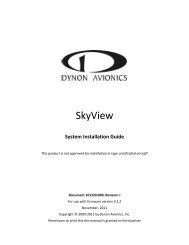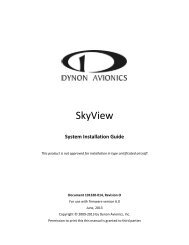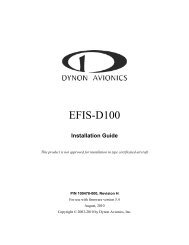EFIS-D60 Installation Guide - Dynon Avionics
EFIS-D60 Installation Guide - Dynon Avionics
EFIS-D60 Installation Guide - Dynon Avionics
Create successful ePaper yourself
Turn your PDF publications into a flip-book with our unique Google optimized e-Paper software.
4. <strong>EFIS</strong> CALIBRATION AND CONFIGURATIONDuring manufacture, your <strong>EFIS</strong>-<strong>D60</strong> underwent a comprehensive calibration, verification, andburn-in routine that minimizes setup time and ensures that your <strong>EFIS</strong>-<strong>D60</strong> meets <strong>Dynon</strong>’sstringent performance specifications. To account for your individual preferences and youraircraft’s particular setup, there are a few simple calibration and configuration steps that youmust complete before using your <strong>EFIS</strong>-<strong>D60</strong>. This section takes you through these steps to makesure that you have properly installed and configured your <strong>EFIS</strong>-<strong>D60</strong>.CAUTION: It is your responsibility to fly your plane safely while performing anyconfiguration or calibration in flight. The best scenario would include a second person toperform any necessary steps on the unit.Ensuring Proper <strong>Installation</strong>Turn your unit on by energizing the aircraft power to which it is connected. Ensure that thescreen is bright and readable and that all instrument displays appear. If a desired display item isnot present, refer to the User’s <strong>Guide</strong> to use the CLUTTR feature to display the missing item.Setting Zero Pitch (In flight)For the purposes of this setting, level is defined as the attitude at which the aircraft’slongitudinal axis is parallel to the ground. For most aircraft, the attitude the aircraftassumes at normal cruise speeds will be acceptable. Additionally, this feature should notbe used to “zero out” pitch when the aircraft is at an attitude other than level. Do notthink of this adjustment as you would the parallax adjustment on a normal attitudeindicator. Instead, think of it as a calibration step which is not changed often.With your aircraft flying straight and level, enter the SETUP > PITCH menu. Press INC or DECuntil the horizon line intersects the center of the crosshairs. It is important that this be done whilethe aircraft is level to ensure proper pitch and roll display throughout all maneuvers.Compass Heading CalibrationThis section guides you through the calibration and configuration of your magnetic headingindication. Prior to calibrating your EDC-D10A, you must configure the local magneticinclination and magnetic intensity as described in the sections below.SETTING MAGNETIC INCLINATION ANGLE AND INTENSITY (REQUIRED)To calibrate your <strong>EFIS</strong>-<strong>D60</strong> heading, you must input your location’s current magneticinclination angle and intensity. Before doing this, you must obtain these two values forthe geographic location where you will be performing the calibration. Note that thisprocedure only needs to be done once, prior to magnetic calibration. Moving the aircraftto another location does not require repeating this procedure.<strong>EFIS</strong>-<strong>D60</strong> <strong>Installation</strong> <strong>Guide</strong> 4-1
















